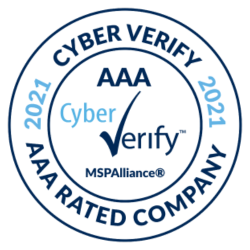October is Cybersecurity Awareness Month – a time when organizations and individuals are encouraged to take stock of their online security practices. However, the importance of cybersecurity cannot be overstated at any time of year. With the increasing frequency of cyberattacks and the sophistication of criminals, businesses and schools alike must be proactive in safeguarding their sensitive data and systems. It’s worth the time and investment to be proactive rather than reactive – and could avoid devastating consequences. In this blog post, we will discuss seven red flags that indicate your organization may not be as cyber secure as it should be.
Red Flag 1: Web-based Email Without Two-Factor Authentication
Email is a common vector for cyberattacks, and web-based email accounts without two-factor authentication (2FA) are particularly vulnerable. If your employees use web-based email services like Gmail or Outlook without enabling 2FA, you’re leaving a significant gap in your cybersecurity defenses. 2FA adds an extra layer of security by requiring users to provide a second form of authentication, such as a one-time code sent to their mobile device via text or preferably an authenticator app, in addition to their password. Without it, hackers can gain access to email accounts more easily, potentially leading to data breaches or unauthorized access to critical information.
Red Flag 2: Employees Responding to Phishing Attempts
Human error is a common factor in many cyber incidents. If your employees have fallen victim to phishing or social engineering attacks and inadvertently responded to emails or even phones calls that led to a compromise, it’s a clear sign that your organization’s cybersecurity awareness and training programs may be lacking. Phishing attacks can be incredibly convincing, and without proper education and awareness, your employees may inadvertently provide sensitive information or access to malicious actors. Take the necessary precautions now to get your employees informed and prepared.
Red Flag 3: Infected Devices in Your Environment
The presence of viruses, malware, or ransomware on one or more devices within your organization is a glaring red flag. These malicious programs can wreak havoc on your systems, encrypt valuable data, and disrupt business operations. All it takes is one compromised machine to give an attacker a beachhead into your organization. Regularly updated endpoint security software on all computers and servers, and centralized monitoring of this software, is essential to detect and mitigate these threats effectively. If you are unsure about choosing and implementing an endpoint security software, we can help.
Red Flag 4: Lack of a Modern Firewall
Firewalls act as a barrier between your internal network and external threats. If your company is still relying on outdated or ineffective firewall technology, you’re leaving your network vulnerable to attacks. Modern firewalls offer advanced threat detection capabilities, intrusion prevention, and better control and visibility over network traffic. Upgrading your environment with a robust firewall solution should be a priority for any organization serious about being cyber secure.
Red Flag 5: Running Outdated Windows Versions
Using outdated operating systems, whether on workstations or servers, is a significant security risk. Older Windows versions such as XP or 7 for workstations, and 2012 R2 or earlier for servers, may lack crucial security updates and patches, making them easy targets for cybercriminals. Regularly updating and patching your systems is crucial to closing security vulnerabilities and reducing the risk of exploitation.
Red Flag 6: Lack of Cybersecurity Insurance
Even the most vigilant organizations can fall victim to cyberattacks. Having cybersecurity insurance is an essential safety net that can help cover the financial costs associated with a data breach or ransomware incident. If your company lacks cybersecurity insurance, you’re taking on substantial financial risk in the event of a breach, including potential legal fees, fines, and costs related to data recovery and customer notification.
Red Flag 7: Inadequate Disaster Recovery Planning
One often overlooked red flag in cybersecurity is the absence of a robust disaster recovery plan. In the event of a breach, many organizations revert to paying ransomware because their backup systems have also been compromised. Without a well-defined backup and disaster recovery plan in place, your organization risks not only the loss of critical data but also being forced into paying hefty ransoms to cybercriminals. An effective disaster recovery plan includes regular backups, off-site storage, and a clear process for restoring systems and data in case of an attack.
Conclusion
Cybersecurity Awareness Month is a great reminder to take a step back from your day-to-day and focus on the importance of protecting your organization. Recognizing and addressing these seven red flags can help you assess and improve your cybersecurity posture. Investing in training, modern technology, cybersecurity insurance, and a robust disaster recovery plan can significantly reduce the risk of a devastating cyber incident and protect your business, school, customers, faculty, students…and ultimately your reputation. Stay vigilant and proactive to ensure your organization remains cyber secure and seek help if you are unsure how.
Spera Partners has experienced staff to provide everything from cybersecurity consultation to implementation. Contact us today for a complimentary consultation or Book a Meeting with our President, Brian Hess to learn more. Discover how we can be your trusted IT partner to protect your business or school from cybercrime.
For Businesses: https://sperapartners.com/business-solution-complimentary-consultation/
For Schools: https://sperapartners.com/Complimentary-Consultation/
Book a Meeting Here
Spera Partners
Learn more about our Cybersecurity at https://sperapartners.com/cybersecurity/







